|
Bourne celebrates Queen Victoria's
Diamond Jubilee in 1897
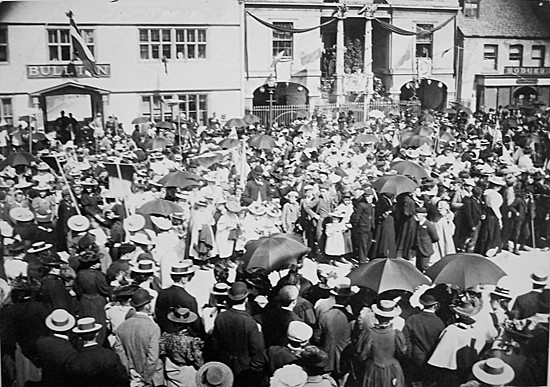
It was a hot and sunny day in Bourne on Tuesday 22nd
June 1897, the day this town celebrated the Diamond Jubilee of Queen Victoria.
We know this because one of the surviving photographs of this auspicious royal
occasion shows the market place thronged with people out enjoying themselves
and although many were sheltering under umbrellas, we may assume that this was
to protect them from the sun.
A local newspaper reported that it was, in fact, the perfect summer's day, one of unalloyed enjoyment for both young and
old. The town was ablaze with colour, national flags adorned every property,
the streets were festooned with red, white and blue bunting while the front of
the Town Hall was a mass of patriotic decorations. A public holiday had been
declared and so the shops and businesses were closed and families turned out
in their Sunday best to stroll around, greet old friends, stop and gossip,
mostly about the grand old lady who had been on the throne for sixty years and
would be celebrating her 80th birthday two years later.
The women and girls all wore long dresses and large hats while the men were
dressed in suits, starched collars and ties, often carried a stick and usually
wore a bowler hat, or more likely a straw boater which became fashionable in
the closing years of the 19th century. It was unheard of for anyone to be seen
in public scruffily dressed on a public occasion and many actually bought new
clothes for such events.
There were special services at all of the town’s churches where ministers
preached sermons on patriotism and loyalty to one’s country, followed by a day
of celebration and enjoyment for both young and old for this special day that
had been long anticipated. “Children were jubilant from daybreak till long
after the legitimate bedtime”, reported the Stamford Mercury, “and
veterans of 70 and 80 were early astir. There was no home undecorated and many
were remarkably beautiful with red roses, evergreens, flags and patriotic
emblems. There appeared to have been a happy rivalry in transforming the old
Saxon town into a place of beauty.”
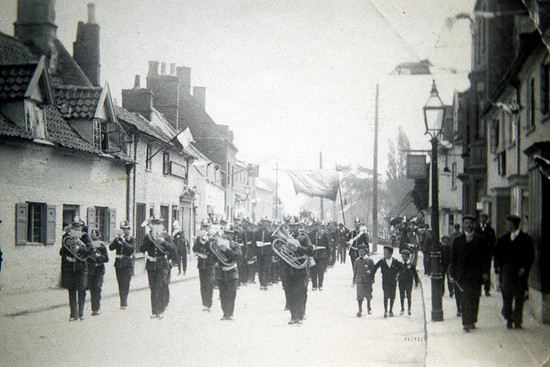
The town was full of people for the rest of the day and at three o’clock,
1,000 schoolchildren gathered in the Market Place to sing God Save the Queen.
The town band then struck up the National Anthem to mark the start of a grand
parade with the Volunteers resplendent in their uniforms and medals close
behind and followed by the friendly societies, always evident on public
occasions carrying their colourful banners. They all marched through the
streets to the Abbey Lawn followed by a huge crowd of people ready to begin
the celebrations consisting of a children’s treat of tea and buns, a programme
of sports, a cycle parade, a supper for the adults in the evening followed by
dancing, fireworks at dusk in the Wellhead Field and to end the day, a
torchlight procession to Stamford Hill on the outskirts of the town where, at
the highest point, a huge bonfire that had been days in the making, some 20
feet in height, was lit to coincide with others across Lincolnshire and
indeed, the entire country.
“It was lighted precisely at ten o’clock”, reported the local newspaper, “and
the flaming tongues that flaked the night must have formed a beacon far across
the fenland towards the sea. From near the bonfire could be seen the fires at
Spalding and Crowland, and lights in the direction of Gosberton, Pinchbeck,
Littleworth, Boston and Peterborough, were discernible. From beginning to end,
the proceedings passed off with perfect success.”
There were also long term benefits for the town from that year’s jubilee
celebrations. The parish council decided to mark the occasion by illuminating
the Town Hall clock at night, an advanced innovation for a public timepiece at
that time. The work was carried out by Edward Pearce, a clock and watch maker
with premises in North Street, and the son of Thomas Pearce who had helped
supply the previous clock.
The clock had been in need of restoration for some time and Mr Pearce fitted a
new dial with gilded hands and black figures in an opal glass, allowing the
clock face to be lit up after dark, the illumination being provided by gas
light regulated by automatic machinery and the old wooden turret or cupola on
the Town Hall was lined with asbestos to render it fireproof. The clock
mechanism was sited in the constable's room below and connected to the dial by
wires. Total cost of the work was £47 14s. 1d. [£3,000 at today's values].
"The illuminated dial of the clock gives universal satisfaction", reported the
Stamford Mercury. "The new clock is a decided improvement for which the parish
councillors may justly claim credit."
Unfortunately, on Saturday 31st October 1933, the gas mechanism used to
illuminate the clock overheated and started a fire which destroyed the wooden
turret on the Town Hall. It was never replaced but the clock remains on the
pediment below although no longer lit up at night.
The Bourne Institute, opened only the previous year in a rented property at No
63 West Street, marked the occasion with a Diamond Jubilee bazaar earlier in
the month and the announcement that the committee intended to buy the premises
for the benefit of its 200 members, including 50 ladies. The building remained
in use as an institute, including a spell as the town’s public library, until
1975 when it became the Pyramid Club which flourishes today.
The other significant development was the establishment of the Town Diamond
Jubilee Nursing Association which eventually led to the opening of the
Butterfield Hospital. The inspiration and much of the work came from Alderman
William Wherry (1841-1915), probably the most industrious of our local
representatives in the history of Bourne. It was his vision that medical
treatment should be available to all in their own homes and once he mentioned
the idea to the Countess of Ancaster, she gave her support and became
patroness while he was elected the first president with an organising
committee to administer day to day affairs.
It was envisaged that the scheme could be introduced for the town at an annual
expenditure of £110 with 20 surrounding villages joining later for a further
sum of £130. Then in 1909, the committee was offered a large detached house
called Brooklands, built of red brick and blue slate and situated at the
corner of North Road and Meadowgate, from the estate of the late Joseph
Butterfield, to be devoted to the relief of suffering and, at Alderman
Wherry’s suggestion, it was converted for use as a cottage hospital which
opened in 1910 with a ceremony performed by Lady Ancaster.
In the ensuing years, the nursing service became a valued medical amenity in
Bourne with more than 2,000 home visits a year and continued until the
introduction of the National Health Service in 1948 while the Butterfield
Hospital, as it became known, was in use until as recently as 1983 when it
closed, although the building became a day care centre for the elderly two
years later and is still a much-loved amenity today.
Of all the royal events in Bourne, this is the best recorded in
pictures. Photography was then becoming extremely popular and this series of
images survives, most probably taken by William Redshaw who had business
premises in North Street.
|
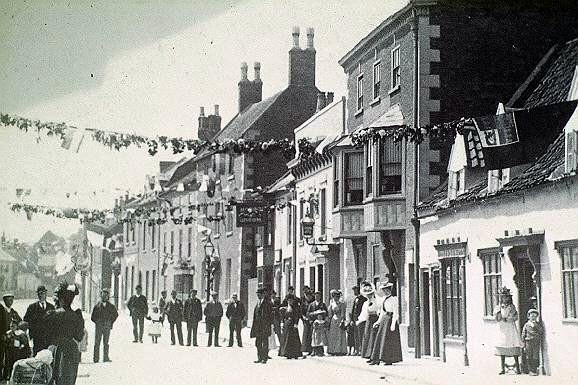 |
|
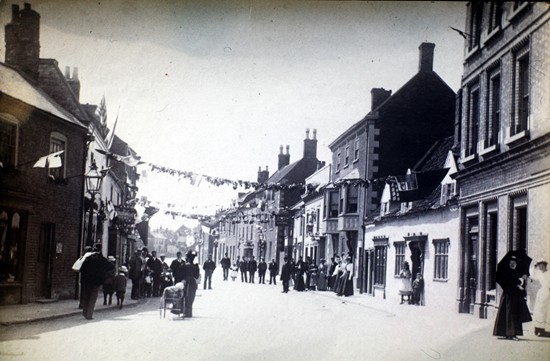 |
|
Flags and bunting were out in Bourne when
the town celebrated Queen Victoria's sixty years on the throne, as
seen in this series of six photographs from Tuesday 22nd June
1897, showing West Street (above), the Market Place (below) and
North Street (bottom). |
|
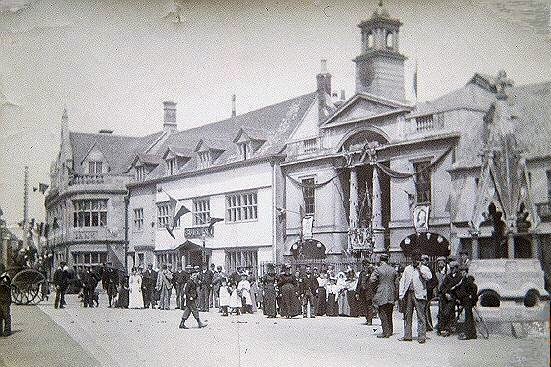 |
|
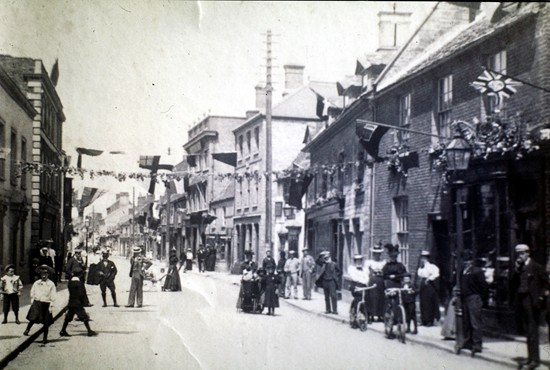 |
|
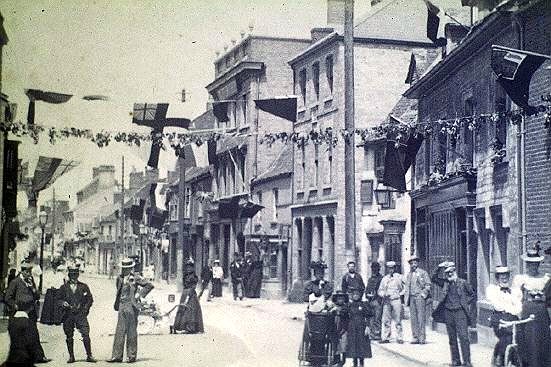 |
See also
Other royal occasions
William Redshaw

Go to:
Main Index Villages
Index
|




